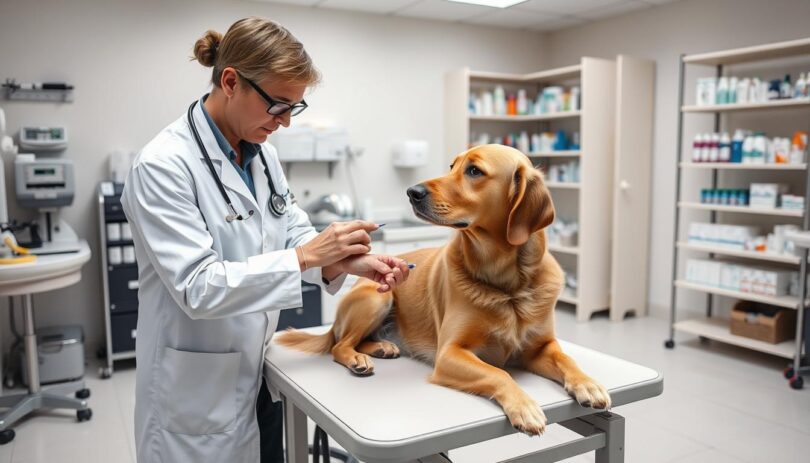Scratching, ear infections, and irritated skin aren’t just minor annoyances for pets—they’re often signs of untreated allergies. Left unmanaged, these issues can escalate into chronic pain or infections. Professional guidance transforms guesswork into actionable care, helping pets thrive.
Specialized allergy testing pinpoints triggers like pollen or food ingredients that evade casual observation. Modern methods like intradermal skin exams or blood analysis offer precise insights, moving beyond trial-and-error approaches. Early intervention prevents months of discomfort and costly complications.
Veterinary dermatologists use this data to craft tailored plans, whether through medication, immunotherapy, or lifestyle adjustments. For example, a dog with recurring ear inflammation might need targeted treatment instead of generic antihistamines. This precision improves outcomes while reducing long-term reliance on medications.
Recognizing subtle symptoms early—like paw-licking or head-shaking—can stop allergies from worsening. Partnering with experts ensures pets receive science-backed solutions, not temporary fixes. The next sections explore how advanced diagnostics and collaborative care create lasting relief.
Understanding Pet Allergies and Their Impact
Persistent paw-licking or sudden skin redness might seem harmless, but these behaviors often signal underlying allergies affecting pets. Unlike temporary irritations, these immune responses can worsen without proper care, leading to chronic issues.
Spotting the Signs Early
Common allergy symptoms include excessive scratching, recurrent ear inflammation, and digestive troubles like vomiting. Pets may rub their faces on carpets or chew their paws until raw. These signs differ from routine skin conditions by their persistence and seasonal patterns.
Daily Life Disruptions
Unmanaged allergies transform simple activities into struggles. A dog avoiding walks due to grass pollen sensitivity or a cat hiding from constant itchiness shows how discomfort alters behavior. Skin infections from repeated scratching further reduce their quality of life.
Environmental triggers like dust mites and food ingredients such as chicken often spark reactions. Vets first rule out flea infestations or bacterial infections through skin scrapings or bloodwork. Early detection prevents minor symptoms from becoming lifelong challenges.
Expert Guidance: Consulting a Veterinarian for Allergy Management
When pets repeatedly shake their heads or develop unexplained rashes, it’s time to involve professionals. Persistent symptoms like recurring ear infections or skin lesions often require advanced diagnosis beyond routine care. Specialists bring clarity to complex cases through targeted testing and evidence-based strategies.
Recognizing the Right Time for Expert Help
Owners should consider referrals if standard treatments fail after 4-6 weeks. Board-certified veterinary dermatologists use specialized tools like microscopic skin analysis to identify hidden triggers. These experts detect patterns casual exams might miss, such as rare food intolerances or environmental sensitivities.
Navigating the Specialist Referral System
Family veterinarians typically initiate the process by documenting treatment history and preliminary test results. They then collaborate with certified veterinary dermatologists to design tailored action plans. This partnership ensures seamless care while leveraging cutting-edge therapies like immunotherapy.
| General Veterinarian Role | Specialist Contribution | Patient Benefit |
|---|---|---|
| Initial symptom assessment | Advanced allergy testing | Precise trigger identification |
| Basic treatment plans | Customized immunotherapy protocols | Long-term symptom control |
| Monitoring progress | Desensitization therapy design | Reduced medication dependence |
Board-certified experts excel at creating multi-phase strategies. For example, they might combine hypoallergenic diets with gradual allergen exposure. This science-backed approach addresses root causes rather than masking discomfort temporarily.
Collaborative care models between local clinics and dermatology centers ensure pets receive consistent support. Studies show pets managed by veterinary dermatologists experience 68% faster symptom resolution compared to standard care alone.
Allergy Testing and Diagnostic Procedures
Accurate diagnosis is the cornerstone of resolving persistent pet allergies. Specialized tests uncover hidden triggers, replacing guesswork with data-driven solutions. Two primary methods—intradermal skin exams and serum testing—guide certified veterinary teams in creating effective care plans.
Intradermal Skin Testing and Its Benefits
Considered the gold standard in veterinary dermatology, this method involves injecting tiny allergen amounts under the skin. Reactions like redness or swelling pinpoint specific triggers, such as pollen or mold. Clinics like VetDERM Clinic use mild sedation during the 2-3 hour process for pet comfort. Results directly shape immunotherapy plans, offering long-term relief instead of temporary fixes.
Understanding Serum Allergy Testing
When skin tests aren’t feasible—due to active ear infections or skin lesions—blood tests measure allergy-related antibodies. This approach identifies food and environmental triggers without direct exposure. Timing matters: testing during flare-ups ensures reliable results, as symptom-free periods may yield false negatives.
Before any test, certified veterinary teams rule out fleas or infections that mimic allergy symptoms. For example, a dog with recurrent skin ear issues might need antibiotics before testing. Combining these diagnostics allows specialists to design precise treatments, reducing trial-and-error approaches. Proper testing transforms frustrating problems into solvable challenges, giving pets lasting comfort.
Customized Treatment and Immunotherapy Solutions
Imagine a world where your pet’s sniffles or itchy paws don’t spiral into sleepless nights. Tailored immunotherapy turns this vision into reality by addressing root causes rather than masking discomfort. Using natural extracts of identified triggers, specialists craft solutions as unique as your furry friend.
Designing a Tailored Allergy Immunotherapy Plan
After pinpointing specific allergens through blood or skin tests, veterinary dermatologists mix customized serums. These contain tiny, controlled doses of problematic substances like pollen or food proteins. Injections or oral drops gradually teach the immune system to tolerate these triggers.
For example, a cat sensitive to dust mites might receive weekly shots with increasing allergen concentrations. This approach reduces sensitivity over months, often cutting medication needs by half. Regular consultations ensure doses stay aligned with evolving reactions.
Managing Long-Term Allergic Reactions
Successful immunotherapy requires teamwork between families and veterinary teams. Dermatologists design protocols while general practitioners monitor progress. Together, they adjust strategies during flare-ups or seasonal changes.
| Response Level | Dogs Improved | Key Benefit |
|---|---|---|
| Excellent | 50% | Minimal symptoms |
| Moderate | 25% | Reduced itching |
| Minimal | 25% | Fewer infections |
Consistency matters—75% of pets show improvement within a year. Follow-up visits track skin health and adjust therapies, preventing secondary issues like chronic ear disease. This proactive care keeps tails wagging for years.
Collaborative Care and Advanced Dermatology Services
When Fluffy can’t stop scratching or develops mysterious rashes, a united front of veterinary experts often holds the solution. Top clinics like Animal Dermatology Clinics and MedVet Dermatology combine family veterinarians’ hands-on knowledge with board-certified specialists’ technical mastery to address stubborn allergy cases.
Integrating Insights from Family and Veterinary Dermatologists
Your local vet’s detailed notes about your pet’s history of itching become invaluable when paired with a dermatologist’s advanced tools. Together, they rule out common fleas or infections before exploring deeper causes. This teamwork ensures no detail—from seasonal symptom patterns to food trial results—gets overlooked.
State-of-the-Art Treatments and Diagnostic Techniques
Modern clinics employ laser therapies for inflamed skin and video otoscopy to examine ear canals in high definition. Skin biopsies detect hidden conditions, while allergen-specific immunotherapy tailors treatment to your pet’s unique triggers. These methods reduce guesswork and accelerate healing.
| Traditional Approach | Advanced Solution | Outcome |
|---|---|---|
| General skin exams | Digital dermoscopy imaging | Pinpoints microscopic inflammation |
| Basic ear cleaning | Video otoscopy-guided treatment | Targets hidden ear infections |
| Trial-and-error diets | Molecular allergy testing | Identifies exact food triggers |
Regular appointments help track progress, while updated health records guide adjustments. This proactive partnership doesn’t just manage symptoms—it restores wagging tails and playful purrs by addressing the root cause.
Final Thoughts on Enhancing Your Pet’s Allergy Care
Seeing your pet enjoy life without constant itching starts with smart choices. Partnering with veterinary teams ensures accurate testing guides treatment plans, from pinpointing triggers to creating personalized therapies. Advanced diagnostics and immunotherapy offer lasting relief by addressing root causes.
Proactive monitoring makes a difference. Notice frequent paw-chewing or ear redness? Schedule an evaluation before symptoms escalate. Early action saves time and prevents secondary infections that complicate recovery.
Modern clinics blend science with compassion. They combine allergy shots, dietary adjustments, and natural remedies into cohesive plans. Collaborative care models mean your regular vet and specialists work together, refining strategies over time.
Ready to help your furry friend thrive? Book a consultation to explore tailored solutions. With expert support, even stubborn allergies become manageable—letting pets focus on playtime, not discomfort.
FAQ
How can I tell if my pet has allergies?
Look for signs like excessive itching, red skin, recurrent ear infections, or paw licking. Pets may also develop rashes or hair loss. Schedule a veterinary consultation if these symptoms persist—early diagnosis improves treatment success.
What’s the difference between intradermal skin testing and serum allergy tests?
Intradermal testing involves injecting small amounts of allergens under the skin to identify reactions, offering precise results. Serum tests measure antibody levels in blood, ideal for pets unable to stop medications before testing. Your vet will recommend the best option based on your pet’s needs.
Can food allergies be diagnosed through allergy testing?
While blood or skin tests help identify environmental allergens, food allergies require elimination diets. Your veterinarian will guide you through an 8–12-week trial with specialized food to pinpoint triggers before creating a long-term nutrition plan.
How does immunotherapy work for pet allergies?
Immunotherapy uses customized injections or oral drops containing small doses of your pet’s allergens. Over time, this reduces their immune system’s overreaction. Many pets see improvement within 3–6 months, with plans adjusted during follow-up dermatology appointments.










Leave a Comment